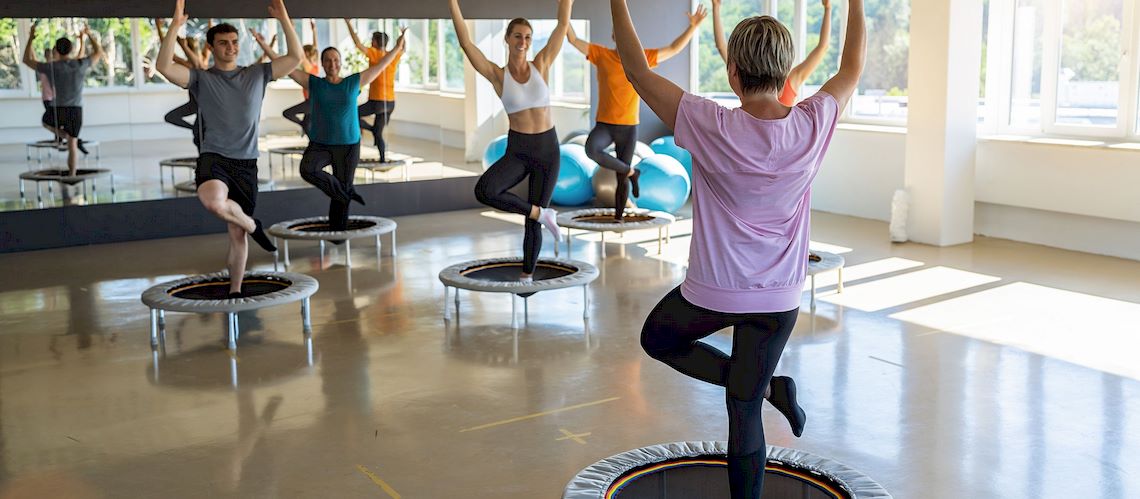Rebounding, or trampoline exercise, is a low-impact, high-efficiency workout that harnesses rhythmic motion on a mini-trampoline to promote health and well-being. This dynamic practice aligns seamlessly with the CORE Compass framework, which emphasizes physical vitality, emotional resilience, intellectual curiosity, and fulfillment. By offering an array of scientifically supported physical and emotional benefits, rebounding serves as a multifaceted tool for cultivating balance and vitality in life.
Rebounding and the CORE Compass Framework
1. Physical Vitality
Rebounding enhances physical vitality through its profound effects on cardiovascular health, body composition, and lymphatic circulation. Research highlights its ability to improve VO₂ max, a critical measure of cardiovascular endurance, while reducing systolic and diastolic blood pressure. These improvements make rebounding particularly valuable for individuals seeking joint-friendly yet high-intensity workouts (Bhattacharya et al., 1980; Cugusi et al., 2018).
Moreover, rebounding promotes fat loss and muscle toning. In a 12-week program, participants experienced significant reductions in fat mass, waist and hip circumference, and increases in lean body mass (Cugusi et al., 2018). This dual capacity to enhance aerobic fitness and body composition makes rebounding a versatile cornerstone of physical vitality.
Rebounding also stimulates the lymphatic system, playing a vital role in detoxification and immune support. The rhythmic bouncing motion encourages the opening and closing of lymphatic valves, which facilitates the removal of toxins and supports immune cell circulation (Brooks, 2003). Although further peer-reviewed research is warranted, the lymphatic benefits are widely recognized in wellness literature.
2. Emotional Resilience
The repetitive, rhythmic nature of rebounding fosters emotional balance by reducing stress and enhancing mood. Exercise-induced endorphin release, often termed the “feel-good hormone effect,” is a key contributor to this benefit (Wegner et al., 2014). Rebounding’s low-impact, engaging format allows individuals to experience the joys of movement without the stress of high-impact activities.
Additionally, rebounding’s potential for reducing anxiety and improving emotional resilience is supported by its rhythmic and meditative qualities. The focused repetition of movements promotes a calming effect, offering a dynamic way to manage stress and enhance overall well-being.
3. Intellectual Curiosity
Rebounding indirectly supports intellectual curiosity by improving cognitive function and mental clarity. Studies demonstrate its capacity to enhance balance, proprioception, and coordination—skills intricately tied to neurological health and cognitive sharpness (Rogers et al., 2003).
Regular rebounding sessions challenge the brain to maintain balance and spatial awareness, fostering neural adaptability. For individuals seeking to optimize their cognitive health, rebounding offers a unique, movement-based approach to promoting mental clarity and lifelong learning.
4. Fulfillment
Rebounding contributes to a sense of fulfillment by empowering individuals to take control of their health and well-being. Its versatility makes it accessible to people of all ages and fitness levels, fostering inclusivity and joy in physical activity. By delivering tangible improvements in energy levels, mood, and physical fitness, rebounding helps individuals feel accomplished and connected to their personal goals.
Expanded Benefits of Rebounding in CORE Compass
Enhanced Cardiovascular Health
Rebounding’s ability to improve cardiovascular endurance is well-documented. Research by NASA showed that rebounding generates sufficient cardiovascular demand to enhance heart health while minimizing joint strain (Bhattacharya et al., 1980). Additional findings indicate its potential to reduce blood pressure and improve VO₂ max, making it an invaluable tool for physical vitality (Cugusi et al., 2018).
Improved Lymphatic Function
Rebounding supports lymphatic health by stimulating fluid circulation and detoxification. According to Brooks (2003), the rhythmic motion of rebounding facilitates the removal of toxins and promotes immune resilience, offering a unique physiological benefit not commonly associated with other forms of exercise.
Stress Reduction and Emotional Balance
Rebounding’s endorphin-boosting effects contribute to better mood regulation and reduced anxiety. The rhythmic nature of rebounding promotes a meditative state that enhances emotional resilience and provides a natural antidote to stress (Wegner et al., 2014).
Cognitive Growth and Balance
Rebounding significantly improves proprioception and coordination, critical for maintaining physical and cognitive health. These benefits extend to mental clarity and focus, essential for intellectual curiosity and cognitive vitality (Rogers et al., 2003).
How to Incorporate Rebounding into the CORE Compass Framework
1. Start Small and Build Consistency
Begin with 10–15 minute sessions, performed 3–4 times a week. Gradually increase the duration and intensity as your fitness and comfort levels improve. Consistency is key to reaping the full spectrum of benefits.
2. Add Variety to Keep It Engaging
Incorporate exercises like twisting jumps, high knees, and balance-focused movements to target different muscle groups and neurological pathways. Variety prevents monotony and ensures a comprehensive workout.
3. Integrate Mindfulness
Use rebounding as a meditative practice by focusing on your breathing and the sensation of movement. This mindful approach enhances the emotional and cognitive benefits of rebounding, aligning it with CORE Compass principles of balance and fulfillment.
4. Track Your Progress
Monitor improvements in physical fitness, emotional well-being, and cognitive sharpness. Tracking your progress can help maintain motivation and provide a clear picture of how rebounding aligns with your broader CORE Compass goals.
Conclusion
Rebounding is more than just an exercise; it is a holistic practice that resonates deeply with the principles of the CORE Compass framework. By enhancing physical vitality, supporting emotional resilience, promoting cognitive growth, and fostering a sense of fulfillment, rebounding offers a dynamic and enjoyable way to achieve balance and well-being. Whether your goal is to build strength, reduce stress, or sharpen your mind, rebounding provides an accessible and effective path to holistic health.
References
Bhattacharya, A., McCutcheon, E.P., Shvartz, E. & Greenleaf, J.E. (1980) ‘Body acceleration distribution and O2 uptake in humans during running and jumping’, Journal of Applied Physiology: Respiratory, Environmental and Exercise Physiology, 49(5), pp. 881–887.
Brooks, L. (2003) Rebounding and Your Immune System. USA: Vitally Yours Press.
Cugusi, L., Wilson, B., Serpe, R., Paribello, P. & Mercuro, G. (2018) ‘Effects of a mini-trampoline rebounding exercise program on functional parameters, body composition and quality of life in overweight women’, The Journal of Sports Medicine and Physical Fitness, 58(3), pp. 287–294.
Rogers, M.E., Rogers, N.L., Takeshima, N. & Islam, M.M. (2003) ‘Methods to assess and improve the physical parameters associated with fall risk in older adults’, Preventive Medicine, 36(3), pp. 255–264.
Smith, J.F. & Bishop, P.A. (1988) ‘Rebounding exercise. Are the training effects sufficient for cardiorespiratory fitness?’, Sports Medicine (Auckland, N.Z.), 5(1), pp. 6–10.
Wegner, M., Helmich, I., Machado, S., Nardi, A.E., Arias-Carrion, O. & Budde, H. (2014) ‘Effects of exercise on anxiety and depression disorders: review of meta-analyses and neurobiological mechanisms’, CNS & Neurological Disorders Drug Targets, 13(6), pp. 1002–1014.




